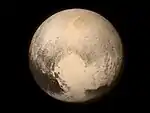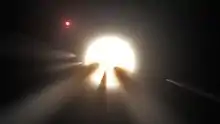| Discovery[1] | |
|---|---|
| Discovered by | Pan-STARRS (F51) |
| Discovery date | 11 January 2015 |
| Designations | |
| 2015 AZ43 | |
| Orbital characteristics[2] | |
| Epoch 13 January 2016 (JD 2457400.5) | |
| Uncertainty parameter 5 | |
| Observation arc | 45 days |
| Aphelion | 2.75773 AU (412.551 Gm) (Q) |
| Perihelion | 0.98830226 AU (147.847914 Gm) (q) |
| 1.87301 AU (280.198 Gm) (a) | |
| Eccentricity | 0.472347 (e) |
| 2.56 yr (936.29 d) | |
| 123.5461° (M) | |
| 0° 23m 4.187s / day (n) | |
| Inclination | 4.52198° (i) |
| 337.42980° (Ω) | |
| 181.78786° (ω) | |
| Earth MOID | 0.00161778 AU (242,016 km) |
| Jupiter MOID | 2.23908 AU (334.962 Gm) |
| Physical characteristics | |
| Dimensions | |
| 0.59992 h (35.995 min) | |
| 23.5[2] | |
2015 AZ43 (also written 2015 AZ43) is an Apollo near-Earth asteroid roughly 70 meters in diameter. On 10 February 2015 with a 29.5-day observation arc, it showed a 1 in 5,880 chance of impacting Earth on 27 February 2107.[3] However, the NEODyS nominal best-fit orbit shows that 2015 AZ43 will be 2.8 AU (420,000,000 km; 260,000,000 mi) from Earth on 27 February 2107.[5] A (non-impacting) Earth close approach in 2056 makes future trajectories diverge.[6] It was removed from the JPL Sentry Risk Table on 23 February 2015 using JPL solution 26 with an observation arc of 40 days that included radar data.[7]
With an absolute magnitude of 23.5,[2] the asteroid is about 50–120 meters in diameter.[4]
2015 flyby
2015 AZ43 was discovered on 11 January 2015 by Pan-STARRS at an apparent magnitude of 20 using a 1.8-meter (71 in) Ritchey–Chrétien telescope.[1] On 15 February 2015 the asteroid passed 0.0197 AU (2,950,000 km; 1,830,000 mi) from Earth.[8] The Goldstone Deep Space Network detected the asteroid on 18–19 February 2015, but the signal was not strong enough for delay-Doppler imaging.[9]
References
- 1 2 "MPEC 2015-B05: 2015 AZ43". IAU Minor Planet Center. 16 January 2015. Retrieved 7 February 2015. (K15A43Z)
- 1 2 3 4 "JPL Small-Body Database Browser: (2015 AZ43)" (last observation: 2015-02-20; arc: 40 days). Jet Propulsion Laboratory. Retrieved 4 April 2016.
- 1 2 "Earth Impact Risk Summary: 2015 AZ43". WayBack Machine: NASA/JPL Near-Earth Object Program Office. 10 February 2015. Archived from the original on 10 February 2015. Retrieved 24 February 2015.
- 1 2 "Absolute Magnitude (H)". NASA/JPL. Archived from the original on 2 March 2001. Retrieved 7 February 2015.
- ↑ "2015AZ43 Ephemerides for 25 February 2107 through 2 March 2107". NEODyS (Near Earth Objects – Dynamic Site). Retrieved 14 February 2015.
- ↑ "2015AZ43 close approaches". NEODyS (Near Earth Objects – Dynamic Site). Retrieved 8 February 2015.
- ↑ "Date/Time Removed". NASA/JPL Near-Earth Object Program Office. Archived from the original on 2 June 2002. Retrieved 24 February 2015.
- ↑ "JPL Close-Approach Data: (2015 AZ43)" (last observation: 2015-02-20; arc: 40 days). Retrieved 24 February 2015.
- ↑ Lance A. M. Benner. "Goldstone Asteroid Schedule". NASA/JPL Asteroid Radar Research. Archived from the original on 19 November 1996. Retrieved 20 February 2015.
External links
- 2015 AZ43 Orbit – Minor Planet Center
- 2015 AZ43 at NeoDyS-2, Near Earth Objects—Dynamic Site
- 2015 AZ43 at ESA–space situational awareness
- 2015 AZ43 at the JPL Small-Body Database


